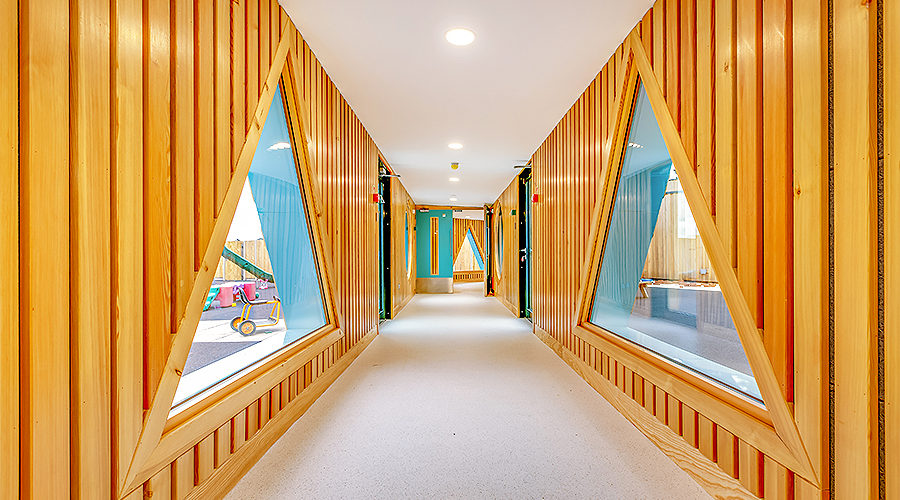As the UK experiences a significant shift towards hotter summers, the challenges in keeping our learning environments cool for students and teachers are becoming increasingly evident. Louise Boddie, Senior Associate at Hudson Architects, explains more.
Hudson Architects
Last year, the country witnessed record-breaking temperatures, reaching 41°C in some regions. This prompted the Met Office to issue a ‘red extreme’ heat warning, resulting in school closures and disruptions. Now, as schools face limited funding and ageing infrastructure, it is crucial for us to explore ways to keep internal temperatures comfortable. Natural and passive cooling opportunities, as well as behavioural changes, can go a long way to provide comfortable learning conditions. Here, we’ll look at some quick-win passive and non-mechanical cooling methods, as well as longer-term solutions to address this issue.
Understanding sunlight
Understanding why some classrooms become unbearably hot while others stay relatively cooler often comes down to the design and orientation of school buildings. Many schools have large south-, east- and west-facing windows that provide ample warmth and natural light during autumn and winter. However, during summer heatwaves, those same windows contribute to overheating at different times of the day. The simplest way to keep the school cool is to reduce the amount of heat getting in in the first place. While internal blinds can provide some relief, external shading is a gamechanger. It blocks the sun’s rays before they have a chance to warm the building, significantly lowering internal temperatures.
Incorporating shading on south- and west-facing facades, where heat gains are greatest, can make a huge difference. This approach is often used in warmer climates, where smaller windows and shading devices are commonly employed to reduce the amount of heat entering the building. Schools can consider cost-effective, passive measures to the areas most in need, like intelligent external shading that allows low-level sun to enter the building in the mornings, evenings and winter, while keeping direct sunlight out during summer.
Retrofitting shading devices to windows, such as overhangs, louvres and external blinds, provides much-needed relief. Going a step further and creating whole-facade solutions that reduce sun absorption through windows and walls can offer substantial benefits, but will be more costly. This could involve adding a secondary shading skin of static or moveable blinds, or louvres oriented horizontally or vertically to suit the sun’s path and building orientation. These can be constructed from timber for its low-carbon qualities and ease of use. It’s also worth considering the building’s materiality and colour. Dark surfaces absorb heat and increase internal temperatures, so adding reflective canvases or resurfacing with lighter colours can radiate heat away.
Understanding how we use our schools
How staff and students move between and use spaces can impact temperature regulation. On hot days, movement between internal and external learning spaces encourages hot air transfer, putting more strain on mechanical cooling systems. By introducing buffer spaces and lobbies, schools can minimise heat gain and loss, reducing the transfer of hot air into the classrooms. Simple internal changes or small extensions can create these intermediate spaces. Additionally, shading structures and canopies at ground-floor level can act as cool external buffer zones, reducing heat gains and providing sheltered areas for play and learning. These structures can be retractable or fixed, contributing to both thermal comfort and increased learning space.
Sometimes, when major retrofitting or infrastructure upgrades aren’t feasible, schools can adapt their teaching and timetabling to tackle overheating. Relocating classes to cooler spaces within the centre of the building, scheduling physical activities during cooler parts of the day, and exploring opportunities for outdoor lessons under canopies or overhangs can all help mitigate heat-related challenges.
Vegetation and planting
Trees and vegetation can be incredibly effective in reducing heat gains, providing shade and lowering surface and air temperatures through evapotranspiration, often by up to 8°. Strategic tree planting can go a long way to keeping schools cooler. Planting deciduous trees near south elevations provides shading during the summer while allowing for seasonal change and natural light during the winter. Vegetation can also be used on shading structures and trellises, creating a cooling effect as plants grow through warmer seasons. Nature-based solutions can have multiple benefits beyond heat reduction including rainwater regulation, improved air quality and increased student health and wellbeing. Take inspiration from those southern European countries where vegetation and planting are used to reduce the temperature of external spaces.
Understanding airflow
Improving ventilation and airflow is crucial for comfortable classrooms, particularly in older buildings without mechanical systems. Understanding how air flows within the school and identifying barriers to airflow can help address stuffiness. Ensuring windows can be opened and creating airflow routes, such as installing opening rooflights, are good potential solutions as is leaving windows open overnight to cool the building for the next day. These measures not only improve air quality but also reduce the reliance on costly, carbon-hungry mechanical cooling systems.
Exploring deeper retrofit options
If all else fails and the building still struggles during summer heatwaves, it may be necessary to explore deeper retrofit options. Fabric upgrades, such as external and internal insulation, and replacing single-glazed windows, can help regulate temperatures, keeping spaces warm in winter while reducing heat gains in summer. External insulation can be installed without too much disruption to teaching. While fabric improvements will go a long way to keep schools cooler, sometimes active mechanical cooling systems will also need to be explored.
While we continue to adapt our construction practices to create new buildings that respond to future changes, it is equally important to give attention to the existing buildings we already have. With passive solutions, such as external shading, utilising vegetation, improving ventilation and adapting our behaviours, we can adjust and change our existing buildings just like we change our clothes and homes with the season, adding and removing layers, using rooms differently, and opening and closing blinds to keep us either cool or warm. Let’s prioritise the comfort and wellbeing of students and teachers by exploring these solutions for our existing educational infrastructure.










